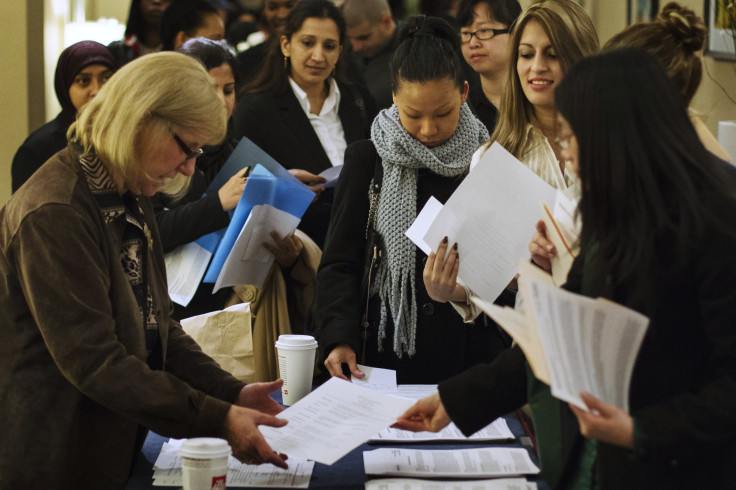US April Nonfarm Payroll Employment Rose 165,000; Unemployment Rate Slips To 7.5%

U.S. employers created 165,000 jobs in April, more than most analysts expected, and the unemployment rate slipped modestly to 7.5 percent, a four-year low, the Bureau of Labor Statistics said on Friday. While stronger than anticipated, job creation in the U.S. remains -- by historic standards -- paltry.
The government's latest gauge of the economy's ability to put Americans back to work indicated that while the climate isn't robust it continues to steadily improve, and it marks a sharp improvement to the March numbers. It also eases concerns that the federal government's budget cuts have not, at least so far, weakened the nation's job creation machine.
Friday's report countered concern earlier this week that hiring might be significantly slowing after the ADP report on private sector employment last month found that businesses added just 119,000 jobs, well below the 150,000 that had been forecast. ADP also cut its March private sector job creation figure down by 27,000 jobs.
The consensus forecast, according to Thomson Reuters, for job creation in April had been 145,000, including 160,000 gains in the private sector and 15,000 cuts by federal, state and local governments. Other surveys of analysts put expectations for job creation last month from a low of 135,000 to a high of 148,000.
The unemployment rate had been expected to remain at 7.6 percent, matching March’s reading as the lowest since December 2008.
The Bureau of Labor Statistics revised upwardly the number of jobs created in February to 332,000 from 268,000 and also revised up the March number to 138,000 from 88,000.
The government's broadest measure of unemployment, which is called U-6, ticked higher in April to 13.9 percent from 13.8 percent. While that’s not good news, it is nevertheless a marked improvement from the 14.5 percent seen a year ago.
"There seems to be a lot of seasonal factors impacting the numbers," Steve Blitz, ITG's chief economist, said. "The decline in construction workers likely reflects better seasonal hiring earlier in the year and the increase in workers at general merchandise store probably comes out of an earlier Easter plus less seasonal hiring leading to less seasonal layoffs. After all, it is hard to imagine this group hiring near 15,000 workers when nominal sales are dropping almost every month."
Stuart G. Hoffman, chief economist with Pittsburgh-based PNC Financial Services Group, said the data indicates Americans actually experienced an increase in income last month.
"It would appear as though, the income people earned in April was the same as what they earned in March," he said. "But since consumer prices fell in April, probably by 0.3 percent, people’s adjusted real income actually rose in April. Overall, this is a good report. It’s not break-out-the-champagne-and-dance-in-the-street, but it’s a good report.
Not all of the data that the BLS released on Friday was positive. While April's numbers are an improvement over the paltry 138,000 jobs created in March -- a nine-month low -- it misses the monthly average of 200,000-plus jobs from November to February. It also misses the 169,000 jobs that have been created, on average, in the prior 12 months. Perhaps most importantly, the April nonfarm payroll report underscores the slow pace of recovery -- worse than any other post-war recession, according to Bill McBride of calculatedriskblog.com.
There were other downbeat datapoints. American workers put in slightly less time on the job in April as the average workweek decreased by 0.2 hours to 34.4 hours. Further, the number of people employed part time for economic reasons rose by 278,000 to 7.9 million, largely offsetting a decrease in March.
"These individuals were working part time because their hours had been cut back or because they were unable to find a full-time job," the BLS said.
The 31,000 increase in temporary employment, the third decent monthly gain in a row, is also a promising sign for permanent employment in the months ahead, Paul Ashworth, chief U.S. economist with London-based Capital Economics, said.
The civilian labor force participation rate was 63.3 percent in April, unchanged over the month but down from 63.6 percent in January. That's well below the 66 percent to 67 percent rate that has been the average over the past two decades. The employment-population ratio, 58.6 percent, was basically unchanged over the month and has shown little movement, on net, over the past year.
"All things considered, 165,000 isn't the biggest monthly gain in payrolls you'll every see, but it's enough to assuage concerns that the economy had stalled again," Ashworth said.
Job gains were noted in professional and business services, food services and drinking places, retail trade and health care. Among demographic groups, adult women experienced the largest decline in unemployment, down to 6.7 percent, while jobless rates for adult men, African-Americans, teenagers, whites and Hispanics showed little change, the BLS said.
The April data could encourage the U.S. central bank to maintain its unprecedented policy of monetary easing.
"What we got in today’s report is a fair reflection of what we have in today’s economy," ITG's Blitz said. "Mediocre growth supported by mediocre jobs growth in industries paying generally mediocre salaries. While the top line numbers are enough to convince people the economy is not about to decelerate, the detail should be enough to convince the Fed that while its current course of policy may not be generating the sector growth they want they are going to keep at it to least keep up the growth we have."
© Copyright IBTimes 2025. All rights reserved.






















